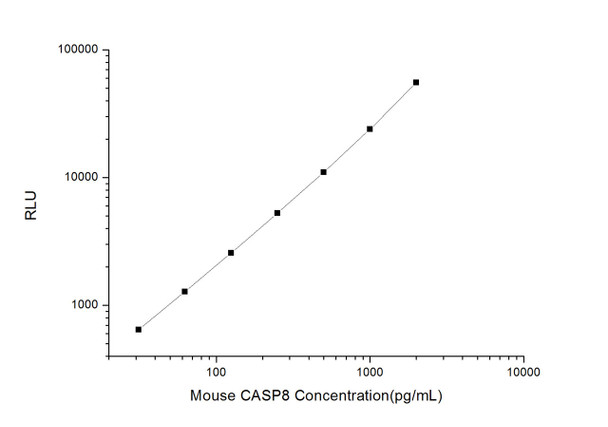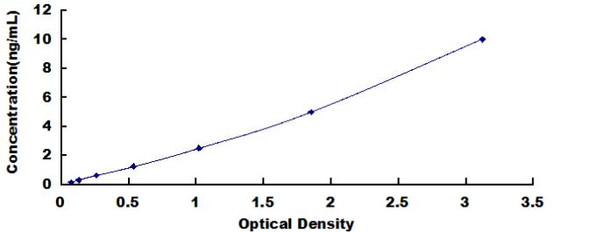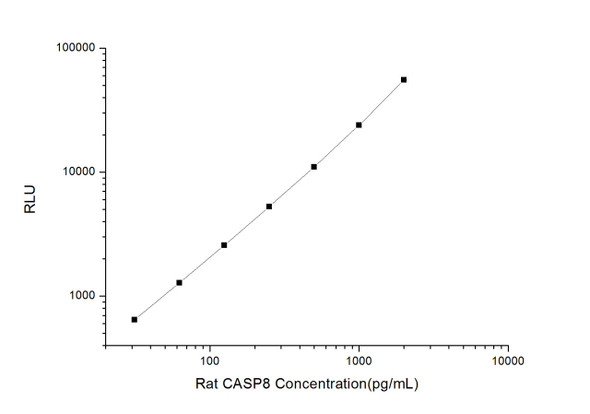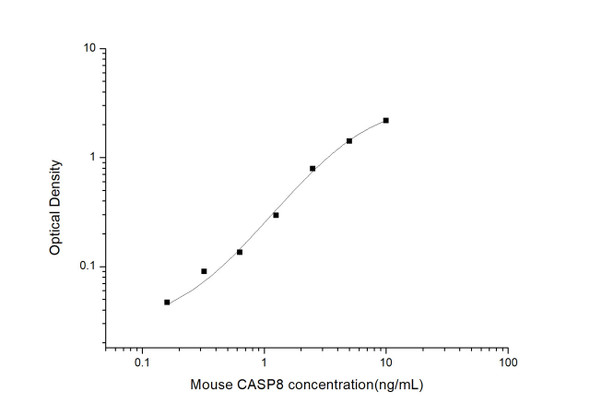Mouse Cell Death ELISA Kits
Mouse CASP8 (Caspase 8) CLIA Kit (MOES00054)
- SKU:
- MOES00054
- Product Type:
- ELISA Kit
- ELISA Type:
- CLIA Kit
- Size:
- 96 Assays
- Sensitivity:
- 18.75pg/mL
- Range:
- 31.25-2000pg/mL
- ELISA Type:
- Sandwich
- Reactivity:
- Mouse
- Sample Type:
- Serum, plasma and other biological fluids
- Research Area:
- Cell Death
Description
| Assay type: | Sandwich |
| Format: | 96T |
| Assay time: | 4.5h |
| Reactivity: | Mouse |
| Detection method: | Chemiluminescence |
| Detection range: | 31.25-2000 pg/mL |
| Sensitivity: | 18.75 pg/mL |
| Sample volume: | 100µL |
| Sample type: | Serum, plasma and other biological fluids |
| Repeatability: | CV < 15% |
| Specificity: | This kit recognizes Mouse CASP8 in samples. No significant cross-reactivity or interference between Mouse CASP8 and analogues was observed. |
This kit uses Sandwich-CLIA as the method. The micro CLIA plate provided in this kit has been pre-coated with an antibody specific to Mouse CASP8. Standards or samples are added to the appropriate micro CLIA plate wells and combined with the specific antibody. Then a biotinylated detection antibody specific for Mouse CASP8 and Avidin-Horseradish Peroxidase (HRP) conjugate are added to each micro plate well successively and incubated. Free components are washed away. The substrate solution is added to each well. Only those wells that contain Mouse CASP8, biotinylated detection antibody and Avidin-HRP conjugate will appear fluorescence. The Relative light unit (RLU) value is measured spectrophotometrically by the Chemiluminescence immunoassay analyzer. The RLU value is positively associated with the concentration of Mouse CASP8. The concentration of Mouse CASP8 in the samples can be calculated by comparing the RLU of the samples to the standard curve.
| UniProt Protein Function: | CASP8: Most upstream protease of the activation cascade of caspases responsible for the TNFRSF6/FAS mediated and TNFRSF1A induced cell death. Binding to the adapter molecule FADD recruits it to either receptor. The resulting aggregate called death- inducing signaling complex (DISC) performs CASP8 proteolytic activation. The active dimeric enzyme is then liberated from the DISC and free to activate downstream apoptotic proteases. Proteolytic fragments of the N-terminal propeptide (termed CAP3, CAP5 and CAP6) are likely retained in the DISC. Cleaves and activates CASP3, CASP4, CASP6, CASP7, CASP9 and CASP10. May participate in the GZMB apoptotic pathways. Cleaves ADPRT. Hydrolyzes the small-molecule substrate, Ac-Asp-Glu-Val-Asp-|-AMC. Likely target for the cowpox virus CRMA death inhibitory protein. Isoform 5, isoform 6, isoform 7 and isoform 8 lack the catalytic site and may interfere with the pro-apoptotic activity of the complex. Heterotetramer that consists of two anti-parallel arranged heterodimers, each one formed by a 18 kDa (p18) and a 10 kDa (p10) subunit. Interacts with FADD, CFLAR and PEA15. Isoform 9 interacts at the endoplasmic reticulum with a complex containing BCAP31, BAP29, BCL2 and/or BCL2L1. Interacts with TNFAIP8L2. Interacts with human cytomegalovirus/HHV-5 protein vICA/UL36; this interaction inhibits CASP8 activation. Isoform 1, isoform 5 and isoform 7 are expressed in a wide variety of tissues. Highest expression in peripheral blood leukocytes, spleen, thymus and liver. Barely detectable in brain, testis and skeletal muscle. Belongs to the peptidase C14A family. 9 isoforms of the human protein are produced by alternative splicing. |
| UniProt Protein Details: | Protein type:Apoptosis; EC 3. 4. 22. 61; Protease Chromosomal Location of Human Ortholog: 1 C1. 3|1 29. 19 cM Cellular Component: CD95 death-inducing signaling complex; cytoplasm; cytosol; lipid raft; microtubule organizing center; mitochondrion; neuron projection; Noc1p-Noc2p complex; nucleoplasm; nucleus; plasma membrane; protein complex Molecular Function:cysteine-type endopeptidase activity; death receptor binding; endopeptidase activity; peptidase activity; protein binding; protein complex binding; protein heterodimerization activity; tumor necrosis factor receptor binding; ubiquitin protein ligase binding Biological Process: angiogenesis; apoptosis; cardiac muscle development; caspase activation; heart development; induction of apoptosis via death domain receptors; macrophage differentiation; negative regulation of I-kappaB kinase/NF-kappaB cascade; neural tube formation; positive regulation of apoptosis; positive regulation of I-kappaB kinase/NF-kappaB cascade; positive regulation of macrophage differentiation; positive regulation of proteolysis; proteolysis; proteolysis involved in cellular protein catabolic process; response to ethanol |
| NCBI Summary: | This gene is part of a family of caspases, aspartate-specific cysteine proteases well studied for their involvement in immune and apoptosis signaling. This protein, an initiator of apoptotic cell death, is activated by death-inducing tumor necrosis family receptors and targets downstream effectors. In mouse deficiency of this gene can cause embryonic lethality. This protein may have a role in embryogenesis. Alternative splicing results in multiple transcript variants that encode different protein isoforms. [provided by RefSeq, Apr 2013] |
| UniProt Code: | O89110 |
| NCBI GenInfo Identifier: | 25090576 |
| NCBI Gene ID: | 12370 |
| NCBI Accession: | O89110. 1 |
| UniProt Secondary Accession: | O89110,O35669, |
| UniProt Related Accession: | O89110 |
| Molecular Weight: | 55,357 Da |
| NCBI Full Name: | Caspase-8 |
| NCBI Synonym Full Names: | caspase 8 |
| NCBI Official Symbol: | Casp8 |
| NCBI Official Synonym Symbols: | MACH; Mch5; FLICE; CASP-8 |
| NCBI Protein Information: | caspase-8 |
| UniProt Protein Name: | Caspase-8 |
| Protein Family: | Caspase |
| UniProt Gene Name: | Casp8 |
As the RLU values of the standard curve may vary according to the conditions of the actual assay performance (e. g. operator, pipetting technique, washing technique or temperature effects), the operator should establish a standard curve for each test. Typical standard curve and data is provided below for reference only.
| Concentration (pg/mL) | RLU | Average | Corrected |
| 2000 | 51598 59844 | 55721 | 55693 |
| 1000 | 21896 26052 | 23974 | 23946 |
| 500 | 11600 10464 | 11032 | 11004 |
| 250 | 4983 5605 | 5294 | 5266 |
| 125 | 2802 2414 | 2608 | 2580 |
| 62.5 | 1331 1291 | 1311 | 1283 |
| 31.25 | 638 710 | 674 | 646 |
| 0 | 27 29 | 28 | -- |
Precision
Intra-assay Precision (Precision within an assay): 3 samples with low, mid range and high level Mouse CASP8 were tested 20 times on one plate, respectively.
Inter-assay Precision (Precision between assays): 3 samples with low, mid range and high level Mouse CASP8 were tested on 3 different plates, 20 replicates in each plate.
| Intra-assay Precision | Inter-assay Precision | |||||
| Sample | 1 | 2 | 3 | 1 | 2 | 3 |
| n | 20 | 20 | 20 | 20 | 20 | 20 |
| Mean (pg/mL) | 109.05 | 309.64 | 857.47 | 105.13 | 317.96 | 896.92 |
| Standard deviation | 11.71 | 31.12 | 91.58 | 11.41 | 37.33 | 67.09 |
| C V (%) | 10.74 | 10.05 | 10.68 | 10.85 | 11.74 | 7.48 |
Recovery
The recovery of Mouse CASP8 spiked at three different levels in samples throughout the range of the assay was evaluated in various matrices.
| Sample Type | Range (%) | Average Recovery (%) |
| Serum (n=5) | 99-115 | 105 |
| EDTA plasma (n=5) | 101-114 | 107 |
| Cell culture media (n=5) | 98-113 | 104 |
Linearity
Samples were spiked with high concentrations of Mouse CASP8 and diluted with Reference Standard & Sample Diluent to produce samples with values within the range of the assay.
| Serum (n=5) | EDTA plasma (n=5) | Cell culture media (n=5) | ||
| 1:2 | Range (%) | 91-106 | 85-97 | 90-104 |
| Average (%) | 99 | 91 | 97 | |
| 1:4 | Range (%) | 85-96 | 95-111 | 89-101 |
| Average (%) | 90 | 102 | 95 | |
| 1:8 | Range (%) | 97-111 | 86-99 | 99-115 |
| Average (%) | 105 | 92 | 106 | |
| 1:16 | Range (%) | 99-113 | 86-98 | 86-98 |
| Average (%) | 106 | 91 | 92 |
An unopened kit can be stored at 4°C for 1 month. If the kit is not used within 1 month, store the items separately according to the following conditions once the kit is received.
| Item | Specifications | Storage |
| Micro CLIA Plate(Dismountable) | 8 wells ×12 strips | -20°C, 6 months |
| Reference Standard | 2 vials | |
| Concentrated Biotinylated Detection Ab (100×) | 1 vial, 120 µL | |
| Concentrated HRP Conjugate (100×) | 1 vial, 120 µL | -20°C(shading light), 6 months |
| Reference Standard & Sample Diluent | 1 vial, 20 mL | 4°C, 6 months |
| Biotinylated Detection Ab Diluent | 1 vial, 14 mL | |
| HRP Conjugate Diluent | 1 vial, 14 mL | |
| Concentrated Wash Buffer (25×) | 1 vial, 30 mL | |
| Substrate Reagent A | 1 vial, 5 mL | 4°C (shading light) |
| Substrate Reagent B | 1 vial, 5 mL | 4°C (shading light) |
| Plate Sealer | 5 pieces | |
| Product Description | 1 copy | |
| Certificate of Analysis | 1 copy |
- Set standard, test sample and control (zero) wells on the pre-coated plate and record theirpositions. It is recommended to measure each standard and sample in duplicate. Note: addall solutions to the bottom of the plate wells while avoiding contact with the well walls. Ensuresolutions do not foam when adding to the wells.
- Aliquot 100µl of standard solutions into the standard wells.
- Add 100µl of Sample / Standard dilution buffer into the control (zero) well.
- Add 100µl of properly diluted sample (serum, plasma, tissue homogenates and otherbiological fluids. ) into test sample wells.
- Cover the plate with the sealer provided in the kit and incubate for 90 min at 37°C.
- Aspirate the liquid from each well, do not wash. Immediately add 100µL of BiotinylatedDetection Ab working solution to each well. Cover the plate with a plate seal and gently mix. Incubate for 1 hour at 37°C.
- Aspirate or decant the solution from the plate and add 350µL of wash buffer to each welland incubate for 1-2 minutes at room temperature. Aspirate the solution from each well andclap the plate on absorbent filter paper to dry. Repeat this process 3 times. Note: a microplatewasher can be used in this step and other wash steps.
- Add 100µL of HRP Conjugate working solution to each well. Cover with a plate seal andincubate for 30 min at 37°C.
- Aspirate or decant the solution from each well. Repeat the wash process for five times asconducted in step 7.
- Add 100µL of Substrate mixture solution to each well. Cover with a new plate seal andincubate for no more than 5 min at 37°C. Protect the plate from light.
- Determine the RLU value of each well immediately.






